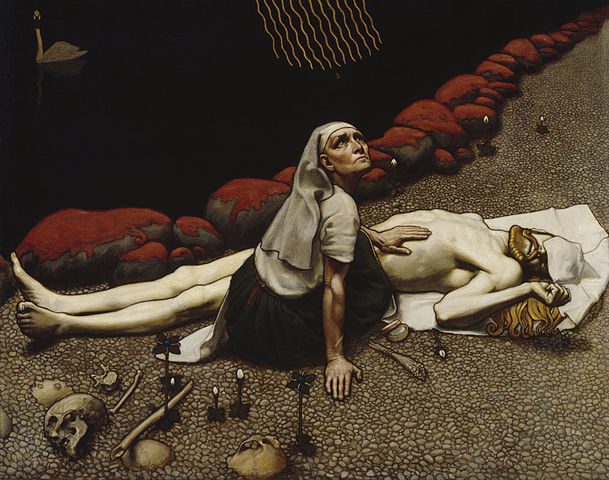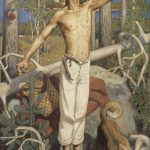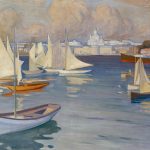
What do national epics and visual art have in common? In Finland, the answer is simple: The Kalevala, the 19th-century epic poem compiled by Elias Lönnrot, and its powerful influence on generations of Finnish artists. The Kalevala is more than just an old poem; it’s a cornerstone of Finland’s identity, culture, and, most importantly for our discussion today, its art.
From the moment of its publication in 1835, The Kalevala has been like an artistic muse for Finnish creators. Its mythic characters, sweeping landscapes, and tales of heroism have inspired everything from Romantic-era paintings to modern interpretations in various artistic forms. So, grab your imaginary brushes and let’s dive deep into the rich, cultural well of The Kalevala, and see how this legendary piece of literature helped shape Finnish art.
How The Kalevala Influenced Finnish Romanticis
At the heart of 19th-century Finnish Romanticism, The Kalevala served as a rallying cry for national pride. Artists like Akseli Gallen-Kallela, arguably one of the most famous Finnish painters, took the themes of the epic and wove them into his canvases with vibrant strokes and powerful symbolism. Gallen-Kallela’s painting “The Defense of the Sampo,” for instance, depicts one of The Kalevala‘s central myths, where mythical characters battle for a magical artifact that ensures prosperity.
In the Romantic movement, art was all about glorifying nature, emotions, and a deep connection to the nation’s spirit. What better way to channel that energy than through the otherworldly stories of The Kalevala? Finnish artists used the epic to symbolize the nation’s struggles for independence, freedom, and a unique cultural identity in the face of outside forces. Many Romantic artists leaned into the magical landscapes described in The Kalevala as metaphors for Finland itself, unspoiled and full of potential.
Romanticism wasn’t just about aesthetics—it was about connecting to a greater cause. These artists saw The Kalevala not as a storybook, but as a living, breathing emblem of what Finland could become.
The Role of Mythology in Finnish Nationalism
Why did The Kalevala become such a prominent force in the national consciousness? Simple: it was a mirror of Finnish identity. As Finland wrestled with its place in the world—especially during periods of domination by Sweden and Russia—The Kalevala offered a narrative that was uniquely Finnish. Finnish artists latched onto this mythological world, using it as a vehicle to express not just the personal, but the political.
Take, for example, the artist Robert Wilhelm Ekman, who incorporated Kalevalaic scenes in his depictions of Finnish life. His work married the contemporary realities of the Finnish people with mythological undertones, suggesting that just as Väinämöinen (the epic’s central character) battled challenges, so too did the Finnish people struggle against their occupiers.
Artists used The Kalevala to tap into a deep well of shared cultural experience. In a way, it gave a fragmented nation a shared history, and from that history, a shared future could emerge. The epic wasn’t just folklore; it was Finland’s roadmap to nationhood.
Akseli Gallen-Kallela: The Master Interpreter of The Kalevala
No conversation about The Kalevala’s artistic influence would be complete without a deep dive into Akseli Gallen-Kallela. If The Kalevala is Finland’s heartbeat, then Gallen-Kallela was its visual interpreter, breathing life into the text through paintings that have become synonymous with Finnish identity.
Gallen-Kallela’s works, including the “Aino Myth” and “The Forging of the Sampo,” are brimming with symbolism and imagination. His technique was deeply rooted in Romanticism but also influenced by Symbolism, which allowed him to depict the ethereal qualities of The Kalevala. His use of bold colors and dramatic composition created an almost otherworldly feeling, aligning perfectly with the magical and mythic tones of the poem.
In his illustrations, Gallen-Kallela didn’t just recreate the text; he expanded it. His work emphasized the struggle and grandeur of The Kalevala’s characters, particularly focusing on the elements of nature and magic. His paintings brought a sense of immediacy and raw emotion to the epic’s timeless tales.
Gallen-Kallela’s interpretations became so iconic that it’s hard to separate his imagery from the text itself. Many modern readers imagine The Kalevala’s heroes as Gallen-Kallela painted them. It’s a reminder of how powerful visual art can be in shaping the way we interpret stories, even ones passed down through centuries.
Modern Interpretations: Kalevala in Contemporary Art
Although Romanticism was a major period for Kalevala-inspired art, the epic hasn’t stayed locked in the 19th century. Contemporary Finnish artists continue to find inspiration in the ancient text, often using modern techniques and styles to interpret the same timeless tales.
Take, for instance, the work of contemporary artist Pauno Pohjolainen, who blends abstract forms with Kalevalaic themes. In his installations and sculptures, Pohjolainen abstracts the human figures and landscapes from The Kalevala, reimagining them in new, often minimalist ways. His works provoke thought about the continuing relevance of ancient stories in a world that looks entirely different from the one Lönnrot inhabited.
Another modern take comes from contemporary digital artist Riitta Nelimarkka, who uses textile and multimedia approaches to reinterpret Kalevalaic themes. Her works, bursting with color and surrealism, give the ancient stories a dreamlike quality, which helps them resonate with new audiences. While they may look nothing like Gallen-Kallela’s representations, they keep the epic alive in modern artistic conversations.
The key takeaway? The Kalevala is evergreen. It evolves with every generation of artists, adapting to new contexts and challenges, but always staying true to its mythic roots.
Visual Symbols and Themes in Kalevala-Inspired Art
What makes The Kalevala such an enduring source of inspiration for Finnish artists? It’s not just the storylines; it’s the potent visual symbols that can be endlessly reimagined. The characters and objects in The Kalevala carry deep meanings that can change depending on the artist’s vision.
Take the Sampo, a mysterious and magical mill that creates riches. Artists often depict the Sampo as a symbol of prosperity and conflict. In paintings like Gallen-Kallela’s “The Defense of the Sampo,” the artifact is both a prize and a burden, representing the endless cycle of desire and destruction.
Then there’s Väinämöinen, often portrayed as an old, wise man. His image has come to symbolize wisdom, magic, and the connection between humanity and nature. In art, Väinämöinen is usually surrounded by natural elements, reinforcing the deep relationship between man and the world around him, a key theme in both The Kalevala and Finnish art in general.
It’s also worth mentioning the depiction of the forests and lakes that are central to Finland’s geography—and The Kalevala. The natural world in these works is more than just a backdrop; it’s a character in its own right, often infused with mythological power. The way these landscapes are portrayed varies from lush, Romantic visions of untouched nature to more abstract and eerie depictions in modern art.
The Kalevala’s Impact on Finnish Design
While we often think of The Kalevala in terms of fine art, its influence extends well into the realm of design. Finnish design is known for its clean lines, functionality, and a deep connection to nature—qualities that have roots in Kalevalaic themes.
Marimekko, a world-famous Finnish design house, has occasionally drawn on The Kalevala for inspiration. While their bold, abstract prints might seem worlds away from Gallen-Kallela’s traditional paintings, the essence of The Kalevala—nature, myth, and the Finnish soul—can still be felt in their designs.
Finnish architecture, too, reflects the same elemental connection to nature found in The Kalevala. Architects like Alvar Aalto embraced the natural world in their designs, often integrating organic forms that echo the forested landscapes of Finland. While Aalto wasn’t directly illustrating The Kalevala, the cultural importance of nature and mythology undoubtedly influenced his approach. In short, The Kalevala has woven itself not just into visual art but into the very fabric of Finnish design sensibilities.
Conclusion: The Kalevala as a Timeless Artistic Muse
In the end, The Kalevala isn’t just a book; it’s a cornerstone of Finnish cultural identity, one that has inspired artists for nearly two centuries. From the sweeping Romantic works of Gallen-Kallela to the sleek, modern interpretations of contemporary designers, the epic’s influence continues to shape Finland’s artistic landscape.
As Väinämöinen himself once said, “Not without art can the world be built.” Okay, that might not be an exact quote, but the sentiment rings true. Whether through paint, sculpture, design, or digital art, the stories of The Kalevala keep reminding us of the power of myth, art, and national pride.
And with that, maybe it’s time for you to dive into The Kalevala yourself. Who knows what inspiration awaits?



